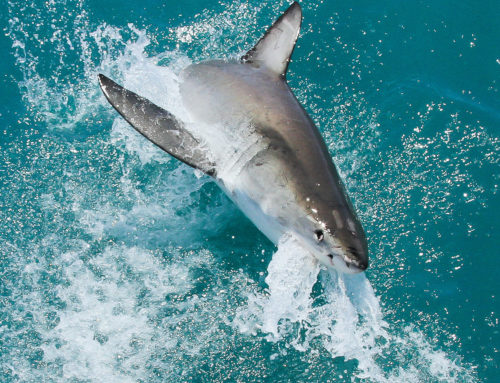Sperm Whale Washes Up In Gansbaai
July 03, 2017 Brenda du Toit
A sperm whale (Physeter macrocephalus) recently washed up in the Pearly Beach area of Gansbaai. As a deep water whale found in most of the world’s ocean, they are not often seen close to shore so this carcass provides a rare opportunity for scientific sampling which is what the Marine Dynamics / Dyer Island Conservation Trust (DICT) team arranged. The whale is in a fairly decayed state.
Sperm whales generally measure about 17m but some up to 20m have been recorded. During the days of commercial whaling, sperm whales were caught off both our east and west coasts – they were so named because when the head was cut open it was found to contain a milky white substance, and the whalers thought the large square head was a huge reservoir for sperm. It is in fact spermaceti oil, thought to help in buoyancy control when diving and acts as an acoustic lens. Additionally, an intestinal secretion called ambergris is found in sperm whales which is used in the perfume industry.
“This is the third sperm whale that has washed up in the Gansbaai area in the last four years which is amazing because we don’t know where they come from. We have DNA samples of all three and will have it analysed and see what further information we can find out,” says Wilfred Chivell of DICT.
The sperm whale belongs to the suborder of toothed whales and dolphins (odontocetes) and is one easily identified by its bushy, angular blow as it has a single blowhole right at the front of the head, on the left. They have between 36-60 conical teeth in their long, narrow lower jaw – in adult males these can grow to 25cm long and weigh 1kg each, although only a third of the tooth appears above the gum. The sperm whale has relatively short, stubby flippers and a low hump instead of a dorsal fin, and triangular tail flukes, which are raised when diving.
The sperm whale is one of the deepest diving mammals in the world. Typically it makes dives of up to 400 m, but can reach depths of up to 2-3km. It is thought to be able to hold its breath for up to two hours, although 45 minutes is the average dive time. Some sperm whales have scars on their bodies caused by rare encounters with feisty giant squid.. Although sperm whales are known to eat a wide variety of sea creatures their major prey items are deep-water squid of less than 3kg in weight. A sperm whale spends most of its life in either ‘nursery schools’ (adult females with young) or ‘bachelor schools’ (males between seven and 27 years of age) although older males tend to live on their own or in very small groups and join nursery schools during the breeding season. The only natural predator of the sperm whale is the orca and even then most attacks are not thought to be fatal.
Sperm whales are protected from commercial whaling but modern threats are ship strikes, injury due to human interactions when they steal fish from longliners, chemical and noise pollution and entanglement in fishing nets, especially ghost gear. The current worldwide population is not known and the conservation status of the sperm whale is listed as Vulnerable (IUCN 2008).






